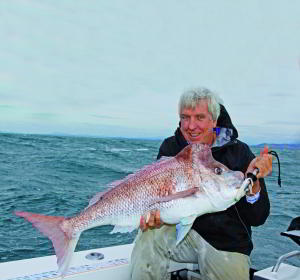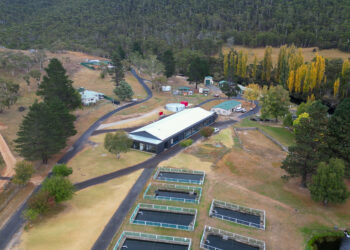Dave Irvine was a great bloke who died way too young.
I fished with Dave on the upper Nymboida River and the Clarence River gorges. He had an infectious enthusiasm for fishing and life in general.
Dave is well known for the invention of the Environet, the first landing net in the country that looked after the health of the fish. His beloved east coast cod and bass were part of the inspiration for this invention, as he really cared a lot about the welfare of the fish he caught.
Dave was fun to be with. I remember fishing the upper Nymboida when my kids were little. We stayed in a magnificent old house near the river, and Dave spent the evening telling my kids all about the “Nymboida panther”. When possums played on the rooftop I woke up with two little kids almost choking me in the night absolutely petrified of the panther.
Dave was a great angler and a wonderful person and is greatly missed by all who knew him.
The Dave Irvine Memorial Snapper Classic is held annually out of Coffs Harbour on the Queen’s birthday weekend in June. This is a lure only catch & release snapper tournament where fish are awarded points based on their length, and anglers compete for trophies based on teams, individuals and biggest fish.
Large specimens are worth a lot of points, so like many similar comps the aim is to catch and release a swag of solid fish. All the prizes are on a lucky draw basis. This year there were thousands of dollars worth of gear up for grabs, including a boat, motor and trailer. This is a fun competition to fish held in a light-hearted way. The competition also has a very active kayak section.
I fished the 2013 event with Jim Harnwell and Chris Yu as part of the Fishing World team onboard Jim’s Bar Crusher. The boys had had quite reasonable fishing on the days prior to my arrival catching a number of decent snapper, kings and tuna on plastics around the washes and shallow reefs that run between Sawtell and Coffs.
Unfortunately the night before the comp saw a 20-knot plus south easterly blow in, and the calm seas I saw on my drive down from the Gold Coast were soon capping and breaking.
I was quite looking forward to fishing offshore from Coffs Harbour. When I was a little kid we spent a lot of our Christmas holidays staying at Coffs. The highlight of these trips for me as a 12-year-old was spending a day out fishing on the local charter boat Pamela Star skippered by Barry Northam. This old boat putted out to sea and we fished with handlines on the close reefs for snapper, teraglin and sand flathead.
When I was a little kid this place was like Costa Rica in terms of fishing appeal. I reckon Barry Northam must have been sick of the sight of me at the end of a trip as I asked him about 500 questions a day. These trips were my first ever experience fishing offshore and were the seeds of a lifelong passion for fishing in the blue water.
Forty years later I was again back fishing offshore from Coffs. The handlines were long gone, the technology was way more sophisticated but the snapper still held in good numbers on the shallow shoals around the entrance of the harbour.
There were about a hundred boats registered to fish in the competition, and it was pretty clear that the weather was going to play a major part in how things eventuated. While the swell was only a bit over a metre, the wind was quite savage and blew the tops off the waves, which made it very uncomfortable to fish soft plastics on light braid.
A lot of crews with good local knowledge travelled a long way in quite small boats to get to their preferred spots, some even venturing as far as Sandon Shoals (I’ve fished there a bit but it is a lot closer to Yamba than Coffs!). That was a gutsy effort in the conditions and a long, wet, bone crunching ride home. Most boats stayed close to the harbour. It was the kind of day where you just normally would stay home and watch the footy.
There’s a shallow shoal known locally as “Bullocky” that is only a couple of kilometres out from the entrance and Jim soon had the Simrad showing some nice rises and scattered fish.
We deployed the sea anchor and began a long drift across the shoal. It was soon clear that to get the plastic into the bite zone would require a bigger jig head than was used on calm days. I opted for a seven-inch white Gulp Nemesis on a three-quarter ounce football head jig head.
There was minimal current and the drift speed was due pretty much solely to wind and sea conditions. We caught quite a few red rock cod but the first hour was pretty quiet, and I didn’t hold out much hope as the sun rose high in the sky.
The only way we could get the jig to stay deep and work it properly was to cast well ahead of the boat, let it sink and then work it back slowly.
At a bit after 8am I felt a fumbling bite and struck to feel the satisfying thump of a big solid fish shaking his head. When you get head shakes on the strike it’s nearly always a good quality jewie or snapper, and this fish powered off a lot of line as it ran close to the bottom.
I only had 10 kilo leader so I had to go slowly and steadily on what was obviously a very decent fish. The rod was a Loomis GLX 803, which was quite light for this type of work. The fish was hard to control from a drifting boat so Chris pulled in the sea anchor and Jim slowly followed the fish as it headed into the sea.
The fish took quite a while to get under control; it was one of those fish you hook in a competition and really get a bit nervous about; the kind that makes your knees tremble. I’ve learnt a lot watching other anglers fight big fish on light threadline tackle.
The secret is to have soft hands, steady even pressure and no changes in direction or rod angles. It is a simple formula. If you keep the hook in the fish and don’t bust the line eventually you’ll catch the fish, regardless of how long it may take.
After about 10 minutes I could feel the fish start to crack. The runs were shorter, it was higher in the water column and the headshakes were more frequent. I soon had colour and the snapper blew his bubbles and was at the boat. He was a very ugly big old man snapper with a huge hump and a bulbous nose.
Despite his magnificent head he was quite thin and in relatively poor condition. On the ruler he was 93cm long and a quick check on the scales showed him to be 21lb, which is a very good snapper but definitely a bit of a fluke in the conditions and spot we fished in.
The sea conditions deteriorated and after another dozen small red rock cod we headed back into the harbour to have lunch and a break. A lot of the smaller boats didn’t venture out that day as the conditions were too uncomfortable.
We headed back out in the late afternoon but the conditions hadn’t improved and we didn’t add to our team score. The brave boats that ventured afar did quite well.
There’s clearly a lot of great snapper grounds in the vicinity of Coffs Harbour, and the switched on crews with good knowledge caught a swag of great fish. Most were caught on deep jigged soft plastics and quite a few fell to Octajigs and similar weighted cuttlefish imitations.
Interestingly, quite a few decent Spanish mackerel were caught and plenty of anglers were snipped off on plastics by roving macks. Catching big Spanish mackerel in June is a bit late in the year but the water was holding at 22 degrees in places and the big winter mackerel are generally fish over 15 kilos, which take a lot of stopping on light threadline tackle.
The wind dropped overnight to about five knots and the sea conditions improved markedly. We headed south to fish some shoals off Sawtell where quite a few nice fish were caught the day prior.
On these shoals there was a lot more pelagic action, with kingies, mackerel tuna and some big Spaniards showing up. There was also quite a lot of bait and despite having mackerel and 22 degree water there were plenty of humpback whales swimming past the fishing boats.
Jim caught a nice kingie on a deep jigged metal, Chris pinned a mack tuna and I caught plenty of unwanted sergeant bakers and red rock cod. Nearby, Fisho’s Mick Fletoridis, fishing with Dan Bode and Stuart Thompson aboard Dan’s plate tinny, hooked a ripper of a Spanish mackerel that nearly spooled him. He had it on for well over an hour, the longest mackerel fight I’ve ever heard of. It ate a seven-inch white Gulp Jerk Shad on 10-kilo fluorocarbon leader in about 15m of water.
Unfortunately, with the fish close to the boat the leader finally wore through. Mick was still crying tears of blood an hour later – the fish was quite probably around 20 plus kilos.
Quite a lot of decent snapper were caught on the second day in much better sea conditions. There were good numbers of quality fish captured and released, the best of the comp going 94cm.
What I really like about the Coffs area is that there are plenty of good shoals in 20 to 30m of water, which makes the area an ideal place for targeting snapper on soft plastics and small metals.
Off the Gold Coast most of the snapper action is on the 60m line or deeper, making it much harder to fish with lures. Coffs Harbour also has plenty of great options from blue marlin to mackerel to popper fishing washes for kings and big tailor. It is a magnificent piece of coastline.
The presentations were held on the Sunday afternoon. The Coffs Harbour Deep Sea Fishing Club has the best location of any fishing club in the country, in my opinion, overlooking the harbour and the beaches to the south of Coffs.
The winning teams caught big numbers of fish on the shoals well north of Coffs (see www.fishingworld.com.au for full comp report listing all winners plus a video filmed by Mick Fletoridis).
It was great to see the spirit and camaraderie of the assembled group of anglers that had travelled from far and wide to fish this unique competition in memory of Dave Irvine.
Editor’s note: For details on the 2014 DIMSC, go to www.deepseafishingclub.com.au.
Fact Box: Coffs Harbour Contacts
- Park Beach Holiday Park – ph. 1800 200 555; www.coffscoastholidayparks.com.au/park-beach-holiday-park/
- Coffs Coast Tourism – www.coffscoast.com.au
- Coffs Harbour International Marina – ph. (02) 6651 4222; www.coffsharbourmarina.com.au
This article was first published in the Fishing World September 2013 issue.

















